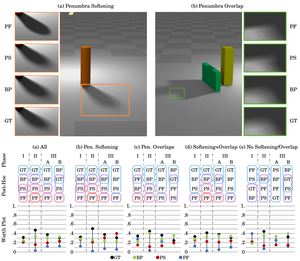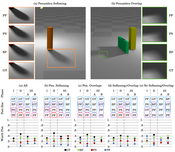Information
- Publication Type: Journal Paper (without talk)
- Workgroup(s)/Project(s):
- Date: June 2014
- ISSN: 1544-3558
- Journal: ACM Transactions on Applied Perception
- Number: 5
- Volume: 11
- Pages: 5:1 – 5:21
- Keywords: Perception Studies, Soft Shadows
Abstract
We performed a perceptual user study of algorithms that approximate soft shadows in real time. Although a huge body of soft-shadow algorithms have been proposed, to our knowledge this is the first methodical study for comparing different real-time shadow algorithms with respect to their plausibility and visual appearance. We evaluated soft-shadow properties like penumbra overlap with respect to their relevance to shadow perception in a systematic way, and we believe that our results can be useful to guide future shadow approaches in their methods of evaluation. In this study, we also capture the predominant case of an inexperienced user observing shadows without comparing to a reference solution, such as when watching a movie or playing a game. One important result of this experiment is to scientifically verify that real-time soft-shadow algorithms, despite having become physically based and very realistic, can nevertheless be intuitively distinguished from a correct solution by untrained users.Additional Files and Images
Weblinks
BibTeX
@article{hecher-2014-MH,
title = "A Comparative Perceptual Study of Soft Shadow Algorithms",
author = "Michael Hecher and Matthias Bernhard and Oliver Mattausch
and Daniel Scherzer and Michael Wimmer",
year = "2014",
abstract = "We performed a perceptual user study of algorithms that
approximate soft shadows in real time. Although a huge body
of soft-shadow algorithms have been proposed, to our
knowledge this is the first methodical study for comparing
different real-time shadow algorithms with respect to their
plausibility and visual appearance. We evaluated soft-shadow
properties like penumbra overlap with respect to their
relevance to shadow perception in a systematic way, and we
believe that our results can be useful to guide future
shadow approaches in their methods of evaluation. In this
study, we also capture the predominant case of an
inexperienced user observing shadows without comparing to a
reference solution, such as when watching a movie or playing
a game. One important result of this experiment is to
scientifically verify that real-time soft-shadow algorithms,
despite having become physically based and very realistic,
can nevertheless be intuitively distinguished from a correct
solution by untrained users.",
month = jun,
issn = "1544-3558",
journal = "ACM Transactions on Applied Perception",
number = "5",
volume = "11",
pages = "5:1--5:21",
keywords = "Perception Studies, Soft Shadows",
URL = "https://www.cg.tuwien.ac.at/research/publications/2014/hecher-2014-MH/",
}



